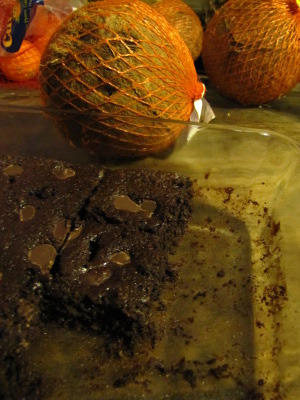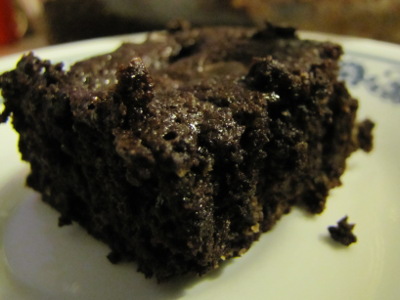
Coconut flour brownies
 Many folks turn to coconut
flour when they decide to ditch
wheat.
Compared to white flour, coconut flour has about the same amount of
protein, but replaces nearly a third of the carbohydrates with good
fats. Coconut flour makes decadent desserts, too, if you like the
taste of coconut and don't mind a bit of denseness in the final product.
Many folks turn to coconut
flour when they decide to ditch
wheat.
Compared to white flour, coconut flour has about the same amount of
protein, but replaces nearly a third of the carbohydrates with good
fats. Coconut flour makes decadent desserts, too, if you like the
taste of coconut and don't mind a bit of denseness in the final product.
Of course, if you live
in the boondocks like we do, you're not going to find coconut flour in
the grocery store. You might find whole coconuts, though, in
which case you can try to make your own. Here's the method we
used to make our coconut flour (and why
you shouldn't follow our lead):
To
make coconut flour the right way, you'll need to first send
the flesh through an oil expeller. I've hit a bit of a wall with
our expeller, but Mark thinks he can
convert it to heating with electricity so that smoke doesn't ruin the
product. If he gets that going, I think we could make real
coconut flour by first expelling the oil, then sending the coconut cake
through the Magic Mill.
No matter how you get
it, here's a delicious recipe for coconut
flour brownies:
 0.5 cups cocoa
0.5 cups cocoa- 0.5 cups coconut flour
- 0.5 cups sugar
- 1 teaspoon baking powder
- 0.5 teaspoons salt
- 2 eggs
- 4 tablespoons butter (or 8 tablespoons if you get the oil out of your flour or use storebought coconut flour)
- 1 teaspoon vanilla
- a small handful of dark chocolate chips
Mix the first seven ingredients together, sprinkle
the chocolate chips on top, and bake at 350 degrees Fahrenheit until a
knife comes out clean. Serves 4 (or 8 if you have self restraint.)
Have you experimented
with coconut flour? I'd be very curious to hear about your
technique if you've made the flour at home.
Want more in-depth information? Browse through our books.
Or explore more posts by date or by subject.
About us: Anna Hess and Mark Hamilton spent over a decade living self-sufficiently in the mountains of Virginia before moving north to start over from scratch in the foothills of Ohio. They've experimented with permaculture, no-till gardening, trailersteading, home-based microbusinesses and much more, writing about their adventures in both blogs and books.
Want to be notified when new comments are posted on this page? Click on the RSS button after you add a comment to subscribe to the comment feed, or simply check the box beside "email replies to me" while writing your comment.

John --- I've tried the same trick you have with raw almonds in the food processor. They make more of a meal than a flour, I think, which makes them good for things like pie crusts but not so good for fluffier pastries. (Or at least that's been my experience.)
Bubbles --- I tried running some wheat through, and it didn't seem to do much good, but I'll happily try rice too! Hopefully that'll clean the gunk out.
A solution of sodium carbonate (washing soda) in warm water is very efficient at removing oils and greases.
I can't imagine a kitchen appliance without some kind of seal between the motor and the wheel. That would be an accident waiting to happen. Most appliances like blenders and grinders allow you to easily disassemble the parts that get dirty for cleaning.
And since it was assembled, it is possible to disassemble it. But it might not be particularly easy. Let Mark have a go at it. Plastic casings these days usually fit together with snap joints. With a small screwdriver or knife blade it is usually possible to open those.
Let Mark have a go at it. Plastic casings these days usually fit together with snap joints. With a small screwdriver or knife blade it is usually possible to open those.